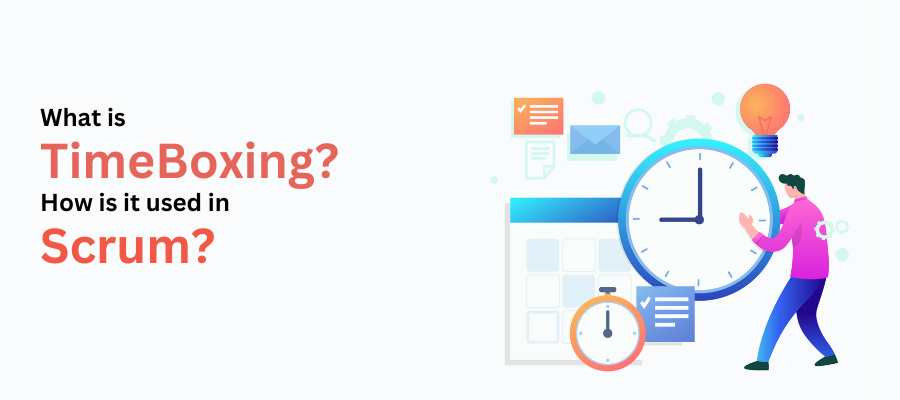What is TimeBoxing and How is it used in Scrum?

TimeBoxing Method is the best way to bound various project activities within a fixed time period. With TimeBoxing, Developers can increase productivity by finishing their dedicated work responsibilities within the allotted time. This time management technique limits the amount of time and a professional’s responsibilities to perform a specific activity in advance.
Definition of TimeBoxing:
The method to allow a fixed amount of time for a specific activity is TimeBoxing, and the selected time unit is called a TimeBox. The ultimate goal of TimeBoxing is to specify work responsibilities with a particular time limit for the Developers, Integration Team, Software Testers, etc.
Timeboxing is now used as a project management methodology to help Agile Practitioners accomplish the ultimate Digital Transformation goals. It gives a helping hand to the Product Owner to provide a clear Definition Of Done. Timeboxing Method also encourages the production teams to get the work done efficiently as soon as possible.
Steve McConnell, the CEO of Construx Software, has stated TimeBoxing as the "Best Practice" for Iterative Development and RAD (Rapid Application Development). The methodology of Scrum as an Agile Approach was also influenced by the TimeBoxing Method. Now the Scrum Master uses the TimeBoxing Method as a critical component for performing his Sprint Planning and other Scrum activities. Let’s dive deep to understand the contribution of TimeBoxing in establishing successful Scrum.
TimeBoxing As A Circular Component for Scrum:
The TimeBoxed Scrum activities get a “fixed length” of time segment for the responsible team to complete the specific event or activity. The Certified Scrum Master sets the goal of timeboxing and limits the amount of dedicated activity time. Let’s discuss the 5 Scrum Events that are TimeBoxed.
1. Sprint:
The Scrum Master uses Timeboxing to define the Sprint length as per the Sprint Goal. Generally, the timebox length for Sprint is of one month or less. The Scrum Team is then responsible to deliver the Sprint Goal accordingly. Organizations can change the Sprint Timebox to one week or more as per the project manager’s recommendations.
2. Sprint Planning:
Sprint Planning initiates the pre-planned Sprint by laying out a roadmap to be followed by the Scrum Team and Developers. During the Sprint Planning, the Product Owner discusses the essential Product Backlog Items and how to map them with the Product Goal. It increases the collaborative efforts of the entire production, testing, and integration teams. It also addresses the following topics:
- Why is the current Sprint valuable?
- What needs to be done in the next Sprint?
- How will the TimeBoxed work get done?
The Scrum Team may also invite attendees from different teams to TimeBox the Sprint Goal activities. Sprint Planning is TimeBoxed as per the Sprint Deliverables.
3. Daily Scrum:
The Daily Scrum meeting offers clear transparency among the Scrum Team, Developers, and Testers. Naturally, the Certified Scrum Product Owner TimeXox this activity with a fixed meeting duration. Daily Scrum happens for at least 15 minutes or more every day. This 15-minute limit is sufficient for each delivery team to brief out their Sprint Progress to others. It synchronizes the Scrum Team activities with development activities to achieve the ultimate Sprint Goal.
4. Sprint Review:
Sprint Review is also TimeBoxed by following the same ratio as Sprint Planning. The time limit should be a minimum of one hour per week and four hours a month. During the Sprint Review, the Scrum Team specifies all Sprint Backlog Items that have been delivered by the Developers so far. During that time, the Scrum Master adapts the Backlog based on individual team feedback. Sprint Reviews allow the stakeholders to inspect the product deliverables.
5. Sprint Retrospective:
The Sprint Retrospective happens to conclude the Sprint. The Scrum Master can TimeBox it for a maximum of three hours during a one-month Sprint. The time limit can be reduced for shorter Sprints depending on the Sprint Goal.
According to the Temporal Motivation Theory, specified time constraints can get the work done efficiently as per the end goal. The sooner the Scrum Master can inspect a deliverable in Scrum, the sooner he can TimeBox the upcoming team activities. Almost all events of Scrum can be TimeBoxed with an average timebox length of 60 to 120 days.
The Benefits Of TimeBoxing for Scrum:
- Prioritize the required Scrum activities that occur during Sprints.
- Focus on the “most important” activities with specified time constraints.
- Set work progress limitations to motivate an early closure.
- Remove all restrictions to maintain continuous work progress.
- Promote perfectionism by making the goals more predictable.
Summing Up The Goal of TimeBoxing in Scrum:
Timeboxing aims to make successful Scrum methodology implementation for the ultimate Agile Transformation. It allows specific time limits for particular team activities. Timeboxing also helps the Scrum Master to prevent exceeding delivery time limits. Scrum Team exclusively collaborates with Developers, Testers, and Administrators through Sprints. As a result, the Product Owner succeeds in achieving the Product Goal with consistent team efforts!
Reference
- https://www.scruminc.com/what-is-timeboxing/
- https://www.visual-paradigm.com/scrum/what-is-time-boxing-in-scrum
- https://en.wikipedia.org/wiki/Timeboxing



